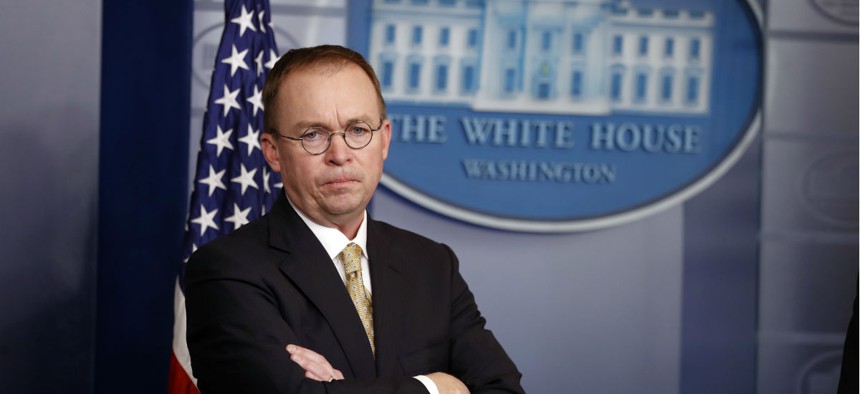White House Will Revise Its 2019 Funding Request In Response to Budget Deal
Matching Trump's priorities with those of Congress will be tricky.
When President Trump signed the Bipartisan Budget Act into law Friday morning, he apparently consigned legions of budgeteers at the Office of Management and Budget to hours of weekend overtime. Because the law blows through the spending caps imposed on agencies under the 2011 Budget Control Act, the administration must now make 11th-hour revisions to its 2019 budget proposal, which it will submit to Congress on Monday.
“Assembling the budget is a months-long process,” OMB dryly noted in a background statement released Friday morning. “As with our FY2018 request, we developed the budget to conform to the overall discretionary spending cap set in law at the time.”
In light of the new agreement, the White House is now modifying its request to account for the higher spending levels, OMB said:
“Simultaneous with our release of the budget, we will release an addendum laying out the administration's roadmap for how to account for the increased spending caps in a responsible manner. It will include additional FY19 funding for a limited set of administration priorities as well as proposals to fix certain budget gimmicks used to circumvent the spending caps. Separate from our FY19 budget request and addendum, we will also be providing technical assistance to Congress on how we recommend Congress allocate funding under the increased FY18 caps.
Squaring the administration’s priorities with those of Congress to reach a two-year spending agreement by March 23, as required under the new law, won’t be easy, something Trump alluded to in a tweet Friday:
Without more Republicans in Congress, we were forced to increase spending on things we do not like or want in order to finally, after many years of depletion, take care of our Military. Sadly, we needed some Dem votes for passage. Must elect more Republicans in 2018 Election!
— Donald J. Trump (@realDonaldTrump) February 9, 2018
Presumably the spending increases will provide enough wiggle room for Republicans and Democrats to each get some things they want. There's an additional $63 billion for non-defense agencies and an additional $80 billion for Defense in 2018. In fiscal 2019, non-defense spending would jump by $68 billion to $597 billion.
The spending agreement far outpaces the two-year budget deals President Obama signed in 2013 and 2015. The measure would raise spending caps by roughly $300 billion over fiscal years 2018 and 2019, about $131 billion of which will go toward domestic agencies. While previous deals only partially repealed the lower spending levels, the new law removes them entirely. It puts them, as Senate Minority Leader Chuck Schumer, D-N.Y., said this week, “in the ash heap of history” for the next two years.
The 2013 deal, struck by current House Speaker Paul Ryan, R-Wis., and Sen. Patty Murray, D-Wash., by comparison raised defense and non-defense spending by a total of $63 billion for fiscal 2014. That is less than half of the increase the new deal sets for fiscal 2018.
“In terms of compared to the last two deals, it is a larger deal,” said David Reich, a senior fellow at the Center on Budget and Policy Priorities. “There is no question about that.”
The 2011 Budget Control Act created two trajectories for federal spending. The upper level were normal limits on discretionary spending for both defense and non-defense agencies. The law also created a “super-committee” to identify measures to decrease federal outlays. Once that failed, agencies faced across-the-board cuts in fiscal 2013 and significantly lower caps in fiscal years 2014 through 2021. This new deal eclipses not only those lower spending levels, but the initial, upper caps as well. Eclipsing those levels was a surprising move for Congress.
“Nobody thought sequester caps were a good idea,” Shai Akabas, director of economic policy for the Bipartisan Policy Center, said of the lower thresholds. “The initial caps were a more thought through and intentional policy.”
While Congress has continued to extend the mandatory side of the BCA caps, the discretionary limits are set to expire in fiscal 2021. This new deal, however, creates a new baseline of spending and makes it far less likely lawmakers will allow spending to sink back to sequester-era levels.
“I think that there will of course be great interest in extending this deal for the last two years of the BCA 2020 and 2021 because without an extension you will have a substantial drop between 2019 and 2020,” Reich said.
That logic also applies to the forthcoming Trump budget and any cuts the administration will recommend.
“As unrealistic as that was originally,” Akabas said of Trump’s proposals, “it will look even more unrealistic as the percentage cut becomes that more aggressive.”
While the cut proposals in Trump’s fiscal 2018 budget were widely rejected by Congress, Reich noted the new budget deal only emphasizes there is little appetite in Congress for significant discretionary spending reductions.
“This deal does show that there is widespread belief that the BCA caps are just too low,” Reich said, “on either side of the budget.”
The budget deal includes a continuing resolution through March 23 to give lawmakers six weeks to set line-by-line appropriations for agencies across government. It is the fifth stopgap measure of the fiscal year. To help alleviate the governing-by-crisis norm that agency leaders have for years complained about, the law also creates a new super-committee to come up with proposals to reform the budget and appropriations process.







